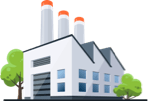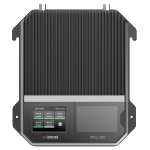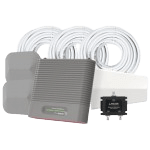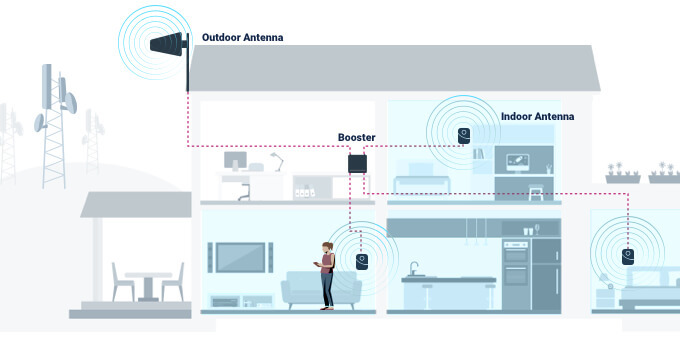Cell Phone Signal Booster Coverage: Expectations vs. Reality
Expectation vs. Reality: The Truth About Cell Phone Signal Booster Coverage
Whether catching up with loved ones or getting a work project over the line, staying connected is so important. But if you've ever dealt with weak cell signals at home or work, you know the frustration of dropped calls, slow data, and those dreaded dead zones. All these can make even simple tasks feel like big challenges. If this sounds like your daily grind, you might be wondering “How Can I Boost My Cell Phone Coverage?”
That’s where cell phone signal boosters come in. These handy devices amplify your existing signal, helping to boost signal coverage indoors and providing a stronger, more reliable connection. In this guide, we'll explore what you can really expect from a signal booster and offer practical tips that will help you stay connected where it matters most.
We fix poor cell phone signal! Find the right signal booster for you:




Expectation: The Promised Square Footage
When you’re dealing with constant dropped calls or poor connection, seeing a signal booster advertise 1,500 or even 10,000 square feet of coverage can feel like a dream solution. Manufacturers use these numbers to help customers like you compare different models in their lineup and understand their relative power—but there’s a bit of a catch.
These figures are based on ideal conditions. In this situation, this means your area has:
- Strong outdoor signal (full bars from the nearest cell tower).
- No indoor obstructions (no thick stone walls, metal structures, or interference).
- Ideal antenna placement (any indoor or outdoor antennas positioned optimally).
So in this perfect-world scenario, you can theoretically boost cell phone coverage up to the square footage advertised. But in the real world? It’s not a guarantee. Let’s explore why.
Further Reading: How Do Signal Boosters Work
Reality: Your Cell Phone Booster Coverage Will Vary
The truth is, if you have a complex building layout, outdoor obstacles, or an already weak outdoor signal, you may only get a fraction of the coverage you initially expected.
The most important thing to note about a cell phone signal booster is that it can only amplify an existing signal—it cannot create one. So if there’s no signal outside, there’s nothing for the booster to amplify.
Put simply, no signal in, no signal out.
But if you do have outdoor signal, the coverage you get inside will depend on a few key factors:
Outside Signal Strength: The Stronger, the Better
If your outdoor cell phone signal is strong (say, 3-5 bars) a booster can deliver wide coverage inside your home or office space. But if your outdoor signal is weak (1-2 bars), your booster has less to work with, which results in smaller coverage and less reliable performance.
Think of it like a megaphone:
If you shout across a crowded room (strong outdoor signal), a megaphone (booster) will amplify the sound so more people hear you. But if you start with a whisper (weak outdoor signal), even the best megaphone isn’t going to carry your voice very far.

Most powerful home signal booster with professional installation included for optimal performance in weak signal environments. Covers up to 7,500 sq ft.
Shop Now: $1,499.99
Commercial-grade booster designed for small to medium businesses and large homes. Significantly enhances in-building coverage up to 10k sq ft whether remote or urban.
Shop Now: $1699.99Building Materials & Layout: The Silent Signal Blockers
Your booster may be working hard, but your building might be working harder against it. Walls, insulation, and other types of building materials can weaken or block signals entirely.
Brick, concrete, and metal are the biggest blockers. These materials make it extremely difficult for signals to penetrate, limiting coverage between rooms. Plaster and drywall are less of an issue but can still weaken signals.
A final factor many people overlook is energy-efficient windows—nice in the winter, of course, but the coated glass can block reception, making it difficult to boost signal coverage indoors.
Room layout also matters. Open layouts allow signals to spread more easily, while partitioned or multi-level areas may require extra antennas to reach all areas.

Most popular home signal booster now includes an extra indoor antenna to bypass interior building materials and extend cellular signals to more rooms – covering up to 5,000 sq ft.
Shop Now: $719.99Antenna Placement: It’s All About Location
Like real estate, proper antenna placement is all about location, location, location. When mounting your outdoor antenna, it should be in the strongest signal location—ideally on a roof or an elevated area. If you have a directional antenna, you’ll need to point it at your carrier’s closest tower. Many devices will help you optimize for this location when setting it up.
Your indoor antenna, on the other hand, should be placed where you need it the most. If you place it too far from where you use your phone may leave you struggling for bars.
Here’s an example of the amount of coverage our most powerful home signal booster may provide based on existing signal strength:

Common Misconceptions About Signal Boosters
Before diving into how to boost cell phone signal coverage, let’s clear up some common myths.
- “A signal booster will give me full bars everywhere.” → Reality: Boosters enhance existing signals, but can’t create them. If your outdoor signal is weak, your indoor coverage will still be limited.
- “More antennas always mean better coverage.” → Reality: In weak signal areas, too many antennas can actually hurt performance by spreading a signal too thin.
- “A booster can fix dead zones.” → Reality: If there’s no outside signal, there’s nothing for the booster to amplify. It simply won’t work.
While this might sound frustrating when you’re already dealing with the headache of dropped calls and poor connections, the good news is that with the right setup, you can significantly boost signal coverage indoors.
How to Maximize Your Cell Phone Signal Booster Coverage
Getting the best boost for your signal comes down to choosing the right model and optimizing placements. Let’s dive into how to get a stronger signal and wider coverage.
Choose the Right Booster for Your Needs
If you’re in a weak signal area, opt for a more powerful booster than the coverage you think you need. Large boosters amplify signals more effectively, resulting in a stronger boost and more reliable performance.
If your outdoor signal is already strong, a standard booster may be enough to improve your signal reception indoors.
Strategic Antenna Placement Matters

Install your outdoor antenna at the highest possible point (roof, pole, attic) for the strongest reception. If you’re using a directional antenna, remember to point it at your carrier’s nearest tower for max efficiency. (Use our Cell Tower Locator here.)
Place your indoor antenna in the most important area when you need the signal the most—such as your office, conference room, or living space. Do note that the boosted signal will spread, but may not reach all your rooms equally due to walls and obstacles we’ve covered above.
Keep in mind too, that it’s crucial not to place your antennas too close to one another. This can cause interference, also known as oscillation. Oscillation can weaken or shut down your booster. See our guide on how to avoid oscillation.
Further Reading: Home Signal Booster Installation Steps
Consider Additional Indoor Antennas (....but with Caution!)

Sometimes no matter what you do, some building layouts cause limited coverage. In this case, adding additional indoor antennas may help extend signals into more rooms, increasing your coverage footprint.
But there’s a kicker. This practice works best for large homes and offices with a strong outside signal. If your area has a weak outdoor signal, adding too many antennas can actually do the opposite and hurt your cell phone signal booster coverage.
Not sure if extra antennas will help your scenario? Call us at 1-800-568-2723, and we’ll talk you through options and determine the best setup for your space.
Troubleshooting Tips to Boost Signal Coverage Indoors
- Not seeing improvements? Double-check your antenna placement and ensure there’s enough distance between indoor and outdoor antennas.
- Still dropping calls? Try repositioning your outdoor antenna for a strong source signal. Remember, higher is usually better!
- Getting a weaker signal than expected? Look for areas of external interference, such as trees, hills, or other buildings and reposition away from these obstacles for a clearer path.
Secure the Strongest Signal When It Matters Most
A cell phone signal booster can make a huge difference in your connectivity, but keep in mind real-world conditions will affect its performance. Factors like the strength of your outdoor signal, the materials used in your building, and how you position your antenna all impact how well the booster works. But when set up correctly, a booster can greatly improve call quality, boost data speeds, and reduce the unfortunate dead zone.
Need a hand finding the ideal booster for your situation? Check out our Best Cell Phone Signal Booster Guide or give us a call at 1-800-568-2723. We’re ready to help you secure the strongest signal possible, right where you need it most.
Interested in Learning More? Check Out Our Signal Boosting Info Center


Money Back Guarantee

Technical Support